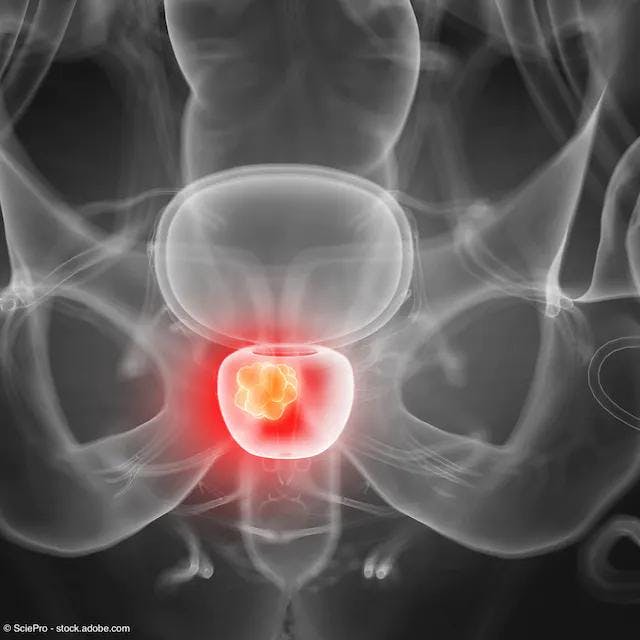Publication
Article
Supplements and Featured Publications
Advances in the Treatment and Management of Metastatic Castration-Sensitive Prostate Cancer
Prostate cancer, one of the most common cancers diagnosed in American men, is associated with a lifetime risk of approximately 12.9%.1,2 An estimated 288,300 new prostate cancer cases will be diagnosed in 2023, with 6 in 10 cases diagnosed in men 65 years or older (median age at diagnosis, 67 years).1-3
Prostate cancer is the second leading cause of cancer-related death among men in the United States, accounting for approximately 34,700 deaths in 2023 and 5.7% of all cancer related deaths.1-3 Prostate cancer is generally associated with relatively good survival rates; however, observed mortality rates tend to be higher among Black individuals and men who are 75 years or older or with advanced stage disease.2 Although the majority of prostate cancer cases initially present as localized (69%) or regional (13%) tumors, approximately 8% of patients are diagnosed with de novo metastatic prostate cancer, and at least 30% will develop metastatic disease after local therapy.2,4
Over the last decade, the overall incidence of prostate cancer has increased by 3% per year with the greatest increases seen in the number of advanced prostate cancer diagnoses (5%).1,3,5 The 5-year survival rate is substantially lower with advanced stage prostate cancer (34.1%) compared with localized disease (100%). Thus, the need for improved treatment approaches and management strategies for patients with metastatic disease continues to grow.2
Prostate Cancer Diagnosis, Staging, and Risk Stratification
Prostate cancer staging and risk stratification schema play an important role in determining disease prognosis and helping to guide overall treatment selection. Prostate cancer is classified and staged using specific criteria established by the American Joint Committee on Cancer (AJCC); these account for 5 key factors—the extent of the primary tumor, lymph node involvement, presence of metastases, prostate-specific antigen (PSA) level upon diagnosis, and grade group based on the Gleason score.6 Similarly, the 2023 National Comprehensive Cancer Network guidelines for risk stratification use the presence of clinical and pathologic features (eg, primary tumor states, PSA level, and Gleason scores) to determine associated disease risk, which ranges from low to very high (Table 1).7
Further subclassification has been proposed for favorable high-risk disease (defined as cT1c [clinical primary tumor identified by needle biopsy found in 1 or both sides, but not palpable], grade group 8, PSA level < 10 ng/mL or cT1c, grade group 1, and PSA level > 20 ng/mL) based on data demonstrating that these patients have lower rates of prostate cancer–specific mortality at 8 years when compared with men having high-risk disease (2.1% vs 7.1%, respectively).8 A subsequent clinical-genomic correlative study involving 3220 men further identified a strong association between the clinical subclassification of high-risk prostate cancer (favorable, standard, or very high risk) with genomic risk markers identified using a 33-gene panel assay.9 Although further subclassification of high-risk disease could allow for improved personalization of therapy, it has not yet been adopted into current guidelines.8
Metastatic Castration-Sensitive Prostate Cancer
Metastatic castration-sensitive prostate cancer (mCSPC), also referred to as metastatic hormone-sensitive prostate cancer (mHSPC), is an advanced form of prostate cancer defined by disease that has spread from the prostate into other regions of the body and that remains responsive to hormone therapy.10 It can further be subdivided according to disease volume (high vs low) or disease risk (high vs low) according to established risk criteria that take into account the presence of bone or visceral metastases and the associated Gleason score. Risk criteria most commonly used for classification are derived from the CHAARTED (NCT00309985) and LATITUDE (NCT01715285) trials (Table 2).11,12
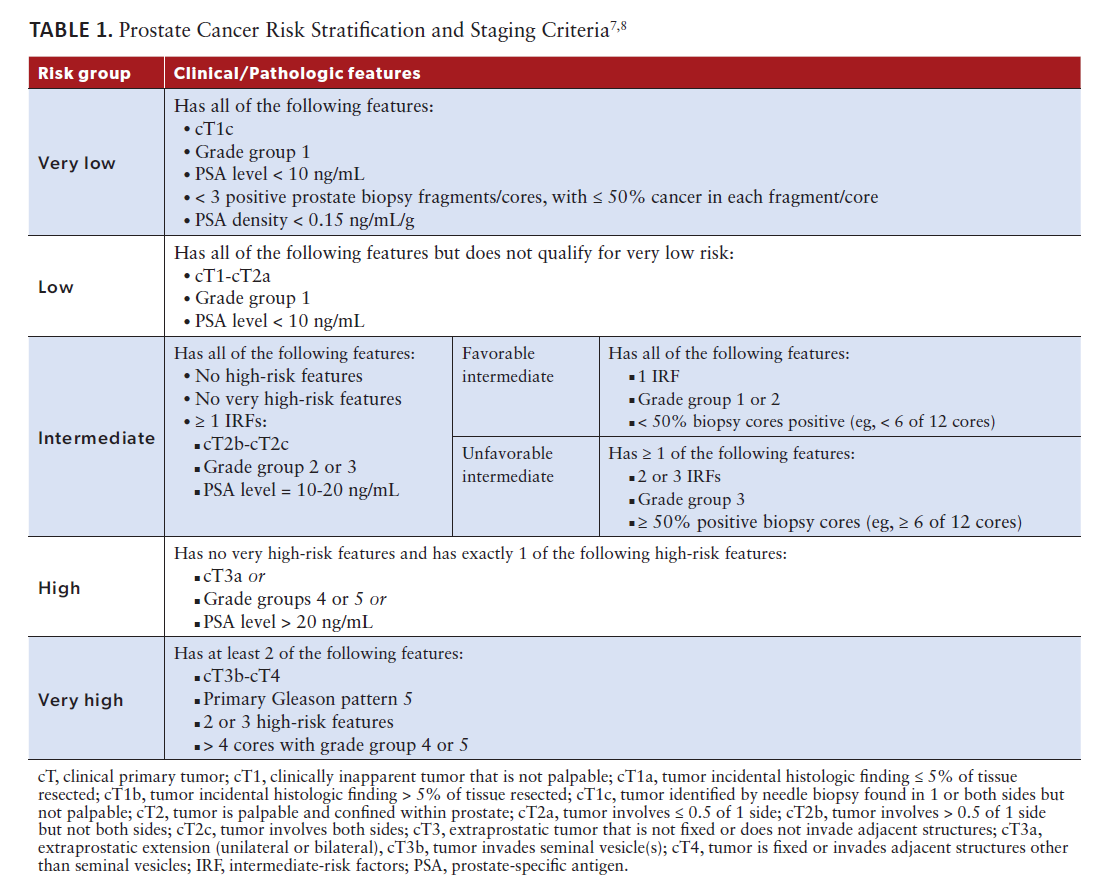
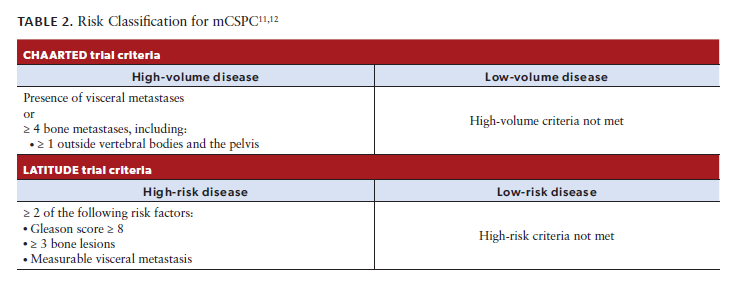
First-Line Treatment Approaches for mCSPC
Doublet Therapy
Surgery and radiotherapy (RT) are the mainstay of treatment for localized disease, but androgen-deprivation therapy (ADT), androgen receptor-signaling inhibition (ARSI), and chemotherapy (eg, docetaxel) constitute standard of care (SOC) for patients with recurrent or metastatic disease. Following the results of early research showing that prostate cancer is an androgen-driven disease that responds to testosterone deprivation, ADT using testosterone suppression with or without AR inhibition was established as the SOC treatment for mCSPC in the early 1940s.10 Early data from the TAX 327 and SWOG9916 trials demonstrated a potential survival benefit with the addition of cytotoxic therapy (docetaxel) to ADT, which initiated a shift toward doublet therapy as a preferred treatment approach.10,13,14
Subsequent study data have since established 2 distinct doublet therapy approaches as new SOC treatments in mCSPC. ADT plus docetaxel for 6 cycles is considered an SOC treatment approach for high-volume mCSPC based on results of the GETUG-AFU 15 (NCT00104715), CHAARTED, and STAMPEDE (C arm) (NCT00268476) studies, which demonstrated a prolonged survival benefit among patients with mCSPC and particularly those with high-volume metastatic disease.10,11,15-17 Based on findings from the LATITUDE and STAMPEDE (arm G) trials, doublet therapy with ADT plus abiraterone acetate continues until disease progression is considered a SOC regimen for all patients with mCSPC.12,17,18
Predictive biomarkers to help guide treatment selection between available doublet therapies are needed. However, use of ADT plus docetaxel may be preferred for patients with mCSPC who have more than 4 metastatic lesions, good performance status, and a desire for shorter treatment duration. Alternatively, ADT plus abiraterone acetate, an androgen receptor pathway inhibitor (ARPI), may be better suited for patients who have fewer than 4 sites of metastases or who are unable to tolerate chemotherapy.17
ARPI-Based Doublet Therapy
Clinical trials investigating next-generation ARPIs (enzalutamide, apalutamide, darolutamide) plus ADT have further expanded available doublet therapy approaches for patients with mCSPC in the first-line setting. A summary of key efficacy and safety end points from select trials evaluating double therapy approaches appears in Table 3.12,19-23
ARCHES
In the randomized, phase 3 ARCHES trial (NCT02677896), the addition of enzalutamide or placebo to ADT was evaluated in men with de novo or recurrent mCSPC.19 Of the 1150 study participants, 63.2% had high-volume disease, and 17.9% had received prior therapy with docetaxel.19
At a median follow-up of 14.4 months, radiographic disease progression was noted in 15.9% of patients receiving enzalutamide plus ADT vs 34.9% placebo plus ADT, and the addition of enzalutamide to ADT significantly reduced the risk of radiographic disease progression or death by 61% (HR, 0.39; 95% CI, 0.30-0.50; P < .001) compared with placebo.19 Upon follow-up analysis of survival data, use of enzalutamide plus ADT led to a 34% reduction in the risk of death vs placebo plus ADT (HR, 0.66; 95% CI, 0.53-0.81; P < .001) with an associated survival benefit demonstrated across most patient subgroups.20
Frequently reported adverse events (AEs) of any grade are listed in Table 3.12,19-23 AEs of grade 3 or greater were similar between treatment arms, with hypertension most frequently reported (3.3% in the enzalutamide arm vs 1.7% in the placebo arm). AEs leading to treatment discontinuation occurred in 7.2% of patients who received enzalutamide plus ADT vs 5.2% of those given placebo.19
TITAN
In the randomized, phase 3 TITAN trial (NCT02489318), doublet therapy with ADT plus either apalutamide or placebo was evaluated in men with mCSPC.21 Of 1052 participants included in the study, approximately 63% of patients were classified as having high-volume disease according to CHAARTED trial criteria.21
Final survival data demonstrated that doublet therapy with apalutamide was associated with a 35% lower risk of death than noted with use of placebo (HR, 0.65; 95% CI, 0.53-0.79; P < .0001), which was deemed significant. At 48 months of follow-up, overall survival (OS) was 65.1% in the apalutamide group vs 51.8% placebo, with favorable OS benefits observed across prespecified subgroups, including patients with high-risk, either high- or low-volume disease.22 Apalutamide use also was related to a 52% lower risk of radiographic progression.21
The incidence of serious AEs of grade 3 or greater did not differ significantly between the apalutamide and placebo treatment arms, with hypertension being the most frequently reported grade 3 AE (8.4% vs 9.1%, respectively). Treatment discontinuation secondary to AEs occurred in 8% vs 5.3% of patients, respectively.21
LATITUDE
In the phase 3 LATITUDE trial, the addition of abiraterone acetate and prednisone (AAP) or placebo to ADT was evaluated in 1199 men with high-risk mCSPC. Interim data at 3 years demonstrated an OS rate of 66% in the AAP group vs 49% in the placebo group.12 When compared with placebo, AAP use also resulted in a 38% lower relative risk of death and a 53% lower relative risk of radiographic disease progression.12 Upon final analysis, AAP demonstrated a continued survival benefit with a longer median survival compared with placebo (53.3 vs 36.5 months, respectively). OS benefit was seen across most patient subgroups, with the exception of patients with a performance status of 2 and those with a Gleason score of less than 8.23
Patients given AAP and those given placebo had similar overall incidences of treatment-related AEs (TRAEs) (95% vs 93%, respectively). Grade 3 mineralocorticoid-related AEs of special interest occurred more frequently in patients receiving AAP vs those given placebo, with hypertension (21% vs 10%) and hypokalemia (12% vs 1%) most reported. Treatment discontinuation due to TRAEs occurred at a rate of 4% in the AAP group vs 2% in the placebo group.23
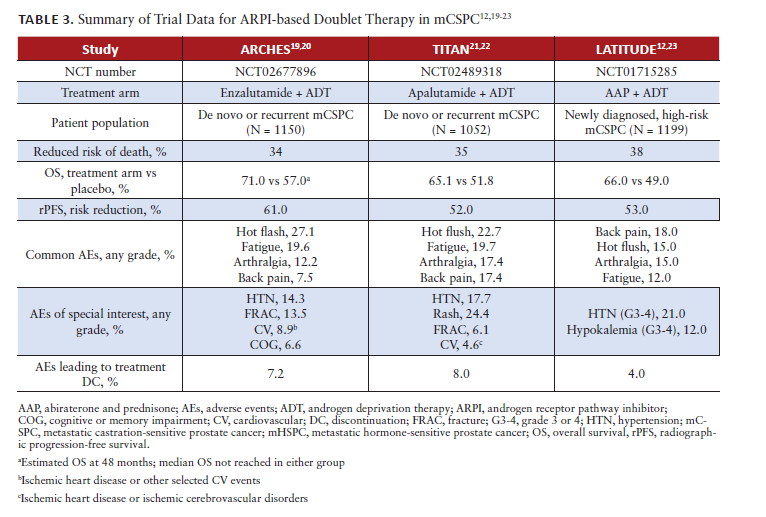
ARPI-Based Triplet Therapy in mCSPC
The treatment landscape for mCSPC has continued to evolve in recent years as outcomes of various phase 3 randomized controlled trials (RCTs) demonstrated favorable survival outcomes using ARPI-based triplet therapy approaches. In 2022, data reported from 2 phase 3 RCTs showed an OS benefit for ARSI-based triplet therapy compared with doublet therapy with docetaxel plus ADT, demonstrating the value of intensive early treatment in mCSPC. Investigators involved in the ARASENS trial (NCT02799602) evaluated the addition of darolutamide to docetaxel plus ADT.24,25 In the PEACE-1 trial (NCT01957436), the addition of AAP to docetaxel plus ADT was evaluated.26 Results of the ENZAMET study (NCT02446405) further demonstrated a clear OS prolongation with concurrent use of early docetaxel and enzalutamide plus ADT.27,28 Table 4 shows a summary of key efficacy and safety data from select trials evaluating triplet therapy approaches.25-29
ENZAMET
In the phase 3 ENZAMET trial, the addition of enzalutamide or placebo to ADT with or without early docetaxel was evaluated. In all, 52% of the 1125 study participants were classified as having high-volume mCSPC.27 At 5-year follow-up, OS and clinical PFS rates were higher in the enzalutamide group than in the placebo group (OS, 67% vs 57%; PFS, 56% vs 28%), respectively. Moreover, the risk of death was 33% lower in the enzalutamide group than in the placebo group. OS and PFS (PSA and clinical) benefits were consistent across subgroups.28
The most common AEs of grade 3 or greater not considered to be associated with concurrent docetaxel were hypertension (10%) and fatigue (6%). AE-related treatment discontinuation occurred in 11% of patients in the enzalutamide group vs 5% of those given placebo.28
ARASENS
The international, randomized, phase 3 ARASENS trial assessed a triplet therapy approach in which darolutamide or placebo was given in combination with ADT plus docetaxel in men with mHSPC. The study included 1306 participants, of whom 77% had high-volume disease and 70% had high-risk disease.25,29
With a median treatment duration of 41 months, triplet therapy with darolutamide reduced the risk of death by 32.5% (HR, 0.68; 95% CI, 0.57-0.80; P < .001). Reported OS at 4 years was 62.7% in the darolutamide group vs 50.4% for those given placebo, and it was consistent across most subgroups.25 Subsequent subgroup analyses by disease volume and risk further revealed an OS benefit among patients with high-volume disease (HR, 0.69; 95% CI, 0.57- 0.82) and high-risk disease (HR, 0.71; 95% CI, 0.58-0.86).29
Common AEs, many of which are known docetaxel-related toxicities, occurred most frequently during periods of docetaxel treatment (Table 4).25,29 AE-associated treatment discontinuation was reported in 13.5% of patients in the darolutamide group vs 10.6% of patients in the placebo group.25
PEACE-1
The addition of AAP to ADT with or without docetaxel and with or without RT was evaluated in the randomized, phase 3 PEACE-1 trial, which included 1173 patients with de novo mCSPC. Treatment was stratified according to study site, performance status, extent of disease burden based on metastatic status (lymph node vs bone vs visceral), and disease volume (high vs low).26
The addition of AAP to ADT with or without docetaxel and with or without RT extended radiographic PFS (rPFS) by a median of 2.1 years and OS by a median of 0.9 years. Associated survival benefits were seen across most subgroups, with a pronounced increase in OS observed among patients with high-volume metastatic burden (median, 1.1 year) (HR, 0.72; 95.1% CI, 0.55-0.95; P < .019).26 However, data from a post-hoc analysis showed that survival benefits associated with abiraterone use may decrease progressively with age, with decreased rPFS and OS reported among men aged 70 years or older.30
Among patients treated with AAP vs those who were not, the incidence of severe AEs of grade 3 or greater were similar; however, patients in the AAP arm more frequently experienced hypertension (22% vs 13%) and hepatotoxicity (increased aminotransferase levels, 6% vs 1%).26

Doublet vs Triplet Therapy in mCSPC
There is a lack of RCTs directly comparing available triplet and doublet therapies; however, several meta-analyses have been conducted to gain greater insights for treatment selection and personalization of therapy. Results of a meta-analysis comparing data from the TITAN, ARCHES, ENZAMET, PEACE-1, and ARASENS trials showed that triplet therapy reduced the risk of death by 27% when compared with doublet therapy (ADT plus docetaxel) (HR, 0.73; 95% CI, 0.65-0.83; P < .00001).31
Pooled HR data assessed in another meta-analysis also revealed a significant reduction in the risk of death with the addition of an ARPI to ADT plus docetaxel (HR, 0.74; 95% CI, 0.66-0.84; P < .00001).32 The OS effect was greater among patients with high-volume disease and synchronous (de novo) disease using a concomitant vs sequential treatment strategy, suggesting a potential for greater OS benefit using a triplet therapy approach in patients with de novo metastatic disease.4 More recent meta-analysis data demonstrated that intensified treatment with triplet therapies can offer improved OS compared with ADT plus docetaxel; however, no significant difference in OS with ARPI-based doublet therapy was noted, suggesting that ARPI-based doublet therapy is a safer treatment option that offers comparable efficacy.32
Considering currently available data, the general consensus among some groups of experts is that a first-line triplet therapy approach may be most appropriate for fit and younger patients with synchronous mCSPC. When a triplet therapy approach is not feasible, a doublet approach with ADT plus docetaxel or ADT plus ARPI is appropriate with comparable efficacy.33
Considerations for Health-Related Quality of Life and Patient Outcomes With Treatment Selection in mCSPC
Although OS and efficacy are key factors in guiding treatment selection, toxicity profiles of individual therapeutic agents and their impact on a patient’s overall quality of life (QOL) are important to consider.
Findings reported in a 2023 systematic review that included data from 6 randomized control trials (ARCHES, ENZAMET, TITAN, STAMPEDE, LATITUDE, and ARASENS) demonstrated that doublet therapy with ARSIs plus ADT increases overall health-related QOL (HRQOL) for patients with mCSPC and prolongs time to first deterioration into pain or fatigue compared with ADT given alone or with first-generation nonsteroidal antiestrogens or docetaxel.34
HRQOL Data From Key Clinical Trials Evaluating ARPI-Based Treatment in mCSPC
Enzalutamide
HRQOL data from the ARCHES trial showed that use of enzalutamide significantly delayed time to first clinically meaningful deterioration (TTFD) for worst pain (14.09 vs 11.10 months; HR, 0.82; P = .032), pain severity (19.38 vs 16.76 months; HR, 0.79; P = .021), and EuroQoL 5-Dimensions, 5 Levels (EQ-5D-5 L) visual analogue scale (VAS) score (11.14 vs 8.38 months; HR, 0.80; P = .0070) when compared with patients who were given placebo.35 According to subgroup analyses by disease volume (high vs low), among patients classified according to CHAARTED criteria, those with high-volume mCSPC had a significant delay in deterioration for several HRQOL subscales and pain severity, but those with low-volume disease had only a modest delay.35
HRQOL data from the ENZAMET trial revealed that at 12 weeks, scores deteriorated more for patients in the enzalutamide group than in the placebo group. Use of placebo was favored over enzalutamide therapy when differences in overall means for fatigue (5.2; P < .001), cognitive function (4.0; P < .001), and physical function (2.6; P <.001) were considered, but this was not noted for overall health and QOL (OHQL) (1.2; P = .1). After 6 months, the enzalutamide group saw greater HRQOL benefits. Deterioration-free survival rates at 3 years and log-rank P values comparing the whole distributions favored enzalutamide therapy over use of placebo for OHQL (31% vs 17%; P < .0001), cognitive function (31% vs 20%; P = .001), and physical function (31% vs 22%; P < .001) but not for fatigue (24% vs 18%; P = .16).36
A systematic review of HRQOL data from the ARCHES, PROSPER (NCT02003924), PREVAIL (NCT01212991), and AFFIRM (NCT00974311) trials further demonstrated that enzalutamide therapy slowed deterioration of overall HRQOL across the prostate cancer continuum, including in men diagnosed with mCSPC and those who developed castration-resistant disease. Benefits in terms of pain mitigation and decreased symptom burden were greatest among patients with advanced disease.37
Apalutamide
Patient outcomes and HRQOL data from the TITAN trial showed apalutamide therapy to be associated with a longer median time to worst pain intensity progression than noted with use of placebo, but the difference failed to achieve statistical significance (19.09 vs 11.99 months; HR, 0.89; 95% CI, 0.75-1.06; P = .20).38 Functional Assessment of Cancer Therapy-Prostate (FACT-P) total scores demonstrated no significant difference in preserved HRQOL, with a median time to deterioration of 8.87 months in the apalutamide group vs 9.23 months in the placebo group (HR, 1.02; 95% CI, 0.85-1.22; P = .85). The EQ-5D-5L VAS scores remained stable between both treatment groups.38
Patient-reported outcomes data showed that pain and fatigue remained stable or improved during treatment in both arms, with greater improvements seen among patients with higher baseline severity scores.39
Final analysis of HRQOL data from the TITAN trial were consistent with earlier findings, showing no significant differences between treatment arms in median time to deterioration in any Brief Pain Inventory or FACT-P scores and no notable worsening of scores over time in either group. Moreover, reported energy levels remained stable or improved with each cycle for more than 78% of patients receiving apalutamide and more than 71% of those given placebo.40
Darolutamide
HRQOL data specifically accessing the effects of darolutamide for patients with mCSPC is relatively limited compared with those with mCRPC; however, outcomes data reported in the ARASENS trial demonstrated that patients receiving darolutamide had significantly longer times to pain progression (HR, 0.79; 95% CI, 0.66-0.95; P = .01) and first symptomatic skeletal event (HR, 0.71; 95% CI, 0.54-0.94; P = .02). Patients in the darolutamide arm also showed a prolonged time to a symptomatic skeletal event-free survival (HR, 0.61; 95% CI, 0.52-0.72; P < .001).25
Abiraterone and Prednisone
According to HRQOL data from the LATITUDE trial, the addition of AAP to ADT consistently improved pain and fatigue symptoms and overall HRQOL in men with high-risk mCSPC when compared with those given placebo.41 Men treated with AAP plus ADT had a significantly longer median time to worst pain intensity progression, worst fatigue intensity progression, and functional deterioration status as demonstrated by FACT-P total scores (AAP, 12.9 months; placebo, 8.3 months) (HR, 0.85; 95% CI, 0.74-0.99; P = .032). Median time to deterioration of well-being was also prolonged in the AAP arm, although median time to deterioration of functional, emotional, and social/family well-being did not substantially differ between treatment arms.41
Findings from the STAMPEDE trial further demonstrated improved HRQOL with the addition of AAP to SOC ADT as shown by higher associated Global-QOL scores at 1 year (+5.7 points) and 2 years (+3.9 points) of follow-up.42 Although observed differences were both statistically significant, only the difference seen at 1 year was considered to be a clinically meaningful difference (ie, predefined threshold of > 4 points).42
Shared Decision-Making in mCSPC
The shared decision-making process involves active participation of patients and their health care providers in selecting the best treatment option based on the patient’s individual needs and preferences. However, assessing individual preferences and values can be challenging. Although no formal process exists, patient-centric decision aids have been developed to enable patients to provide information and input into the treatment decision-making process.
Decision aids allow systematic assessment and incorporation of patient preferences and values to rank potential treatment options by likelihood of achieving the preferred outcome. A preference-based approach may help patients through their decision-making process, potentially affecting adherence to treatment, tolerance of AEs, and satisfaction with the decision.43
Future Perspectives
As progression to castration resistance is an adaptive process, ongoing efforts to assess the benefits of deintensification and adaptive treatment strategies continue. Intermittent therapy approaches have been investigated to minimize treatment exposure, thereby reducing the potential for AEs and improving HRQOL. More recently, there has been a growing interest identifying response-based end points that could help guide adaptive treatment strategies. However, a lack of conclusive data with some clinical trials has led to some heterogeneity in treatment practices. Future research is needed to shed further light on this subject.10
With an increased number of deleterious genetic alterations correlating with progression from localized to advanced prostate cancer, there is a growing interest in identifying novel biomarkers that may help to better inform treatment decision-making and expand the understanding and development of personalized and targeted therapies for mCSPC.
Advancements in the treatment of prostate cancer have led to improved survival, especially in patients with synchronous, high-volume disease.10 However, novel treatment approaches that improve personalization of therapy and decrease the unbalanced burden of advanced disease are still needed.10
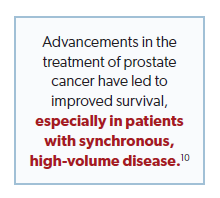
REFERENCES
1. Key statistics for prostate cancer. American Cancer Society. Revised January 12, 2023. Accessed August 8, 2023. https://www.cancer.org/content/dam/CRC/PDF/Public/8793.00.pdf
2. Cancer stat facts: prostate cancer. National Cancer Institute. Accessed August 8, 2023. https://seer.cancer.gov/statfacts/html/prost.html
3. Siegel RL, Miller KD, Wagle NS, Jemal A. Cancer statistics, 2023. CA Cancer J Clin. 2023;73(1):17-48. doi:10.3322/caac.21763
4. Maiorano BA, De Giorgi U, Roviello G, et al. Addition of androgen receptor-targeted agents to androgen-deprivation therapy and docetaxel in metastatic hormone-sensitive prostate cancer: a systematic review and meta-analysis. ESMO Open. 2022;7(5):100575. doi:10.1016/j.esmoop.2022.100575
5. Desai MM, Cacciamani GE, Gill K, et al. Trends in incidence of metastatic prostate cancer in the US. JAMA Netw Open. 2022;5(3):e222246. doi:10.1001/ jamanetworkopen.2022.2246
6. Prostate cancer stages. American Cancer Society. Revised October 8, 2021. Accessed August 8, 2023. https://www.cancer.org/content/dam/CRC/PDF/ Public/8795.00.pdf
7. NCCN. Clinical Practice Guidelines in Oncology. Prostate cancer, version 2.2023. Accessed August 6, 2023. https://www.nccn.org/professionals/physician_gls/pdf/ prostate.pdf
8. Muralidhar V, Chen MH, Reznor G, et al. Definition and validation of “favorable high-risk prostate cancer”: implications for personalizing treatment of radiation-managed patients. Int J Radiat Oncol Biol Phys. 2015;93(4):828-835. doi:10.1016/j. ijrobp.2015.07.2281
9. Muralidhar V, Zhang J, Wang Q, et al. Genomic validation of 3-tiered clinical subclassification of high-risk prostate cancer. Int J Radiat Oncol Biol Phys. 2019;105(3):621-627. doi:10.1016/j.ijrobp.2019.06.2510
10. Hamid AA, Sayegh N, Tombal B, et al. Metastatic hormone-sensitive prostate cancer: toward an era of adaptive and personalized treatment. Am Soc Clin Oncol Educ Book. 2023;43:e390166. doi:10.1200/EDBK_390166
11. Sweeney CJ, Chen YH, Carducci M, et al. Chemohormonal therapy in metastatic hormone-sensitive prostate cancer. N Engl J Med. 2015;373(8):737-746. doi:10.1056/NEJMoa1503747
12. Fizazi K, Tran N, Fein L, et al; LATITUDE Investigators. Abiraterone plus prednisone in metastatic, castration-sensitive prostate cancer. N Engl J Med. 2017;377(4):352-360. doi:10.1056/NEJMoa1704174
13. Tannock IF, de Wit R, Berry WR, et al; TAX 327 Investigators. Docetaxel plus prednisone or mitoxantrone plus prednisone for advanced prostate cancer. N Engl J Med. 2004;351(15):1502-1512. doi:10.1056/NEJMoa040720
14. Petrylak DP, Tangen CM, Hussain MH, et al. Docetaxel and estramustine compared with mitoxantrone and prednisone for advanced refractory prostate cancer. N Engl J Med. 2004;351(15):1513-1520. doi:10.1056/NEJMoa04131
15. Gravis G, Boher JM, Joly F, et al; GETUG. Androgen deprivation therapy (ADT) plus docetaxel versus ADT alone in metastatic non-castrate prostate cancer: impact of metastatic burden and long-term survival analysis of the randomized phase 3 GETUG-AFU15 trial. Eur Urol. 2016;70(2):256-262. doi:10.1016/j.eururo.2015.11.005
16. James ND, Sydes MR, Clarke NW, et al; STAMPEDE Investigators. Addition of docetaxel, zoledronic acid, or both to first-line long-term hormone therapy in prostate cancer (STAMPEDE): survival results from an adaptive, multiarm, multistage, platform randomised controlled trial. Lancet. 2016;387(10024):1163- 1177. doi:10.1016/S0140-6736(15)01037-5
17. Hahn AW, Higano CS, Taplin ME, Ryan CJ, Agarwal N. Metastatic castration-sensitive prostate cancer: optimizing patient selection and treatment. Am Soc Clin Oncol Educ Book. 2018;38:363-371. doi:10.1200/EDBK_200967
18. Attard G, Murphy L, Clarke NW, et al; Systemic Therapy in Advancing or Metastatic Prostate Cancer: Evaluation of Drug Efficacy (STAMPEDE) investigators. Abiraterone acetate and prednisolone with or without enzalutamide for high-risk non-metastatic prostate cancer: a meta-analysis of primary results from two randomised controlled phase 3 trials of the STAMPEDE platform protocol. Lancet. 2022;399(10323):447-460. doi:10.1016/S0140- 6736(21)02437-5
19. Armstrong AJ, Szmulewitz RZ, Petrylak DP, et al. ARCHES: a randomized, phase III study of androgen deprivation therapy with enzalutamide or placebo in men with metastatic hormone-sensitive prostate cancer. J Clin Oncol. 2019;37(32):2974-2986. doi:10.1200/JCO.19.00799
20. Armstrong AJ, Azad AA, Iguchi T, et al. Improved survival with enzalutamide in patients with metastatic hormone-sensitive prostate cancer. J Clin Oncol. 2022;40(15):1616-1622. doi:10.1200/JCO.22.00193
21. Chi KN, Agarwal N, Bjartell A, et al; TITAN Investigators. Apalutamide for metastatic, castration-sensitive prostate cancer. N Engl J Med. 2019;381(1):13- 24. doi:10.1056/NEJMoa1903307
22. Chi KN, Chowdhury S, Bjartell A, et al. Apalutamide in patients with metastatic castration-sensitive prostate cancer: final survival analysis of the randomized, double-blind, phase III TITAN study. J Clin Oncol. 2021;39(20):2294-2303. doi:10.1200/JCO.20.03488
23. Fizazi K, Tran N, Fein L, et al. Abiraterone acetate plus prednisone in patients with newly diagnosed high-risk metastatic castration-sensitive prostate cancer (LATITUDE): final overall survival analysis of a randomised, double-blind, phase 3 trial. Lancet Oncol. 2019;20(5):686-700. doi:10.1016/S1470-2045(19)30082-8
24. Hoeh B, Garcia CC, Wenzel M, et al. Triplet or doublet therapy in metastatic hormone-sensitive prostate cancer: updated network meta-analysis stratified by disease volume. Eur Urol Focus. Published online April 11, 2023. doi:10.1016/j. euf.2023.03.024
25. Smith MR, Hussain M, Saad F, et al; ARASENS Trial Investigators. Darolutamide and survival in metastatic, hormone-sensitive prostate cancer. N Engl J Med. 2022;386(12):1132-1142. doi:10.1056/NEJMoa2119115
26. Fizazi K, Foulon S, Carles J, et al; PEACE-1 Investigators. Abiraterone plus prednisone added to androgen deprivation therapy and docetaxel in de novo metastatic castration-sensitive prostate cancer (PEACE-1): a multicentre, open-label, randomised, phase 3 study with a 2 × 2 factorial design. Lancet. 2022;399(10336):1695-1707. doi:10.1016/S0140-6736(22)00367-1
27. Davis ID, Martin AJ, Stockler MR, et al. Enzalutamide with standard first-line therapy in metastatic prostate cancer. N Engl J Med. 2019;381(2):121-131. doi:10.1056/NEJMoa1903835
28. Sweeney CJ, Martin AJ, Stockler MR, et al. Testosterone suppression plus enzalutamide versus testosterone suppression plus standard antiandrogen therapy for metastatic hormone-sensitive prostate cancer (ENZAMET): an international, open-label, randomised, phase 3 trial. Lancet Oncol. 2023;24(4):323-334. doi:10.1016/S1470-2045(23)00063-3
29. Hussain M, Tombal B, Saad F, et al. Darolutamide plus androgen-deprivation therapy and docetaxel in metastatic hormone-sensitive prostate cancer by disease volume and risk subgroups in the phase III ARASENS trial. J Clin Oncol. 2023;41(20):3595-3607. doi:10.1200/JCO.23.00041
30. Mourey L, Boyle HJ, Roubaud G, et al. Efficacy and safety of abiraterone acetate plus prednisone and androgen deprivation therapy +/- docetaxel in older patients (≥70 years), with de novo metastatic-castration sensitive prostate cancer, compared to younger patients (<70 years): the PEACE-1 trial. J Clin Oncol. 2023;41(suppl 6):20. doi:10.1200/JCO.2023.41.6_suppl.20
31. Ciccarese C, Iacovelli R, Sternberg CN, Gillessen S, Tortora G, Fizazi K. Triplet therapy with androgen deprivation, docetaxel, and androgen receptor signalling inhibitors in metastatic castration-sensitive prostate cancer: a meta-analysis. Eur J Cancer. 2022;173:276-284. doi:10.1016/j.ejca.2022.07.011
32. Riaz IB, Naqvi SAA, He H, et al. First-line systemic treatment options for metastatic castration-sensitive prostate cancer: a living systematic review and network meta-analysis. JAMA Oncol. 2023;9(5):635-645. doi:10.1001/ jamaoncol.2022.7762
33. Oing C, Bristow RG. Systemic treatment of metastatic hormone-sensitive prostate cancer-upfront triplet versus doublet combination therapy. ESMO Open. 2023;8(2):101194. doi:10.1016/j.esmoop.2023.101194
34. Afferi L, Longoni M, Moschini M, et al. Health-related quality of life in patients with metastatic hormone-sensitive prostate cancer treated with androgen receptor signaling inhibitors: the role of combination treatment therapy. Prostate Cancer Prostatic Dis. Published online April 13, 2023. doi:10.1038/s41391-023-00668-0
35. Stenzl A, Dunshee C, De Giorgi U, et al. Effect of enzalutamide plus androgen deprivation therapy on health-related quality of life in patients with metastatic hormone-sensitive prostate cancer: an analysis of the ARCHES randomised, placebo-controlled, phase 3 study. Eur Urol. 2020;78(4):603-614. doi:10.1016/j. eururo.2020.03.019
36. Stockler MR, Martin AJ, Davis ID, et al; ENZAMET Trial Investigators and the Australian and New Zealand Urogenital and Prostate Cancer Trials Group (ANZUP). Health-related quality of life in metastatic, hormone-sensitive prostate cancer: ENZAMET (ANZUP 1304), an international, randomized phase III trial led by ANZUP. J Clin Oncol. 2022;40(8):837-846. doi:10.1200/JCO.21.00941
37. Tombal B, Stenzl A, Cella D, et al. The impact of enzalutamide on the prostate cancer patient experience: a summary review of health-related quality of life across pivotal clinical trials. Cancers (Basel). 2021;13(23):5872. doi:10.3390/ cancers13235872
38. Agarwal N, McQuarrie K, Bjartell A, et al; TITAN Investigators. Health-related quality of life after apalutamide treatment in patients with metastatic castration-sensitive prostate cancer (TITAN): a randomised, placebo-controlled, phase 3 study. Lancet Oncol. 2019;20(11):1518-1530. doi:10.1016/S1470- 2045(19)30620-5
39. Agarwal N, McQuarrie K, Bjartell A, et al. Patient-reported outcomes (PROs) from TITAN: A phase III, randomized, double-blind study of apalutamide (APA) versus placebo (PBO) added to androgen deprivation therapy (ADT) in patients (pts) with metastatic castration-sensitive prostate cancer (mCSPC). Ann Oncol. 2019;30(suppl 5):v330-V331. doi:10.1093/annonc/mdz248.008
40. Agarwal N, Chowdhury S, Bjartell A, et al; TITAN investigators. Health-related quality of life (HRQoL) and patient-reported outcomes at final analysis of the TITAN study of apalutamide (APA) versus placebo (PBO) in patients (pts) with metastatic castration-sensitive prostate cancer (mCSPC) receiving androgen deprivation therapy (ADT). J Clin Oncol. 2021;39(suppl 15):5068. doi:10.1200/ JCO.2021.39.15_suppl.5068
41. Chi KN, Protheroe A, Rodríguez-Antolín A, et al. Patient-reported outcomes following abiraterone acetate plus prednisone added to androgen deprivation therapy in patients with newly diagnosed metastatic castration-naive prostate cancer (LATITUDE): an international, randomised phase 3 trial. Lancet Oncol. 2018;19(2):194-206. doi:10.1016/S1470-2045(17)30911-7
42. Rush HL, Murphy L, Morgans AK, et al. Quality of life in men with prostate cancer randomly allocated to receive docetaxel or abiraterone in the STAMPEDE trial. J Clin Oncol. 2022;40(8):825-836. doi:10.1200/JCO.21.00728
43. Bagshaw HP, Martinez A, Heidari N, et al. A personalized decision aid for prostate cancer shared decision making. BMC Med Inform Decis Mak. 2021;21(1):374. doi:10.1186/s12911-021-01732-2
Newsletter
Stay current with the latest urology news and practice-changing insights — sign up now for the essential updates every urologist needs.




